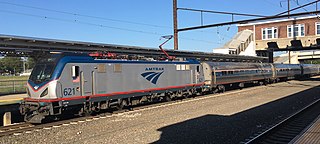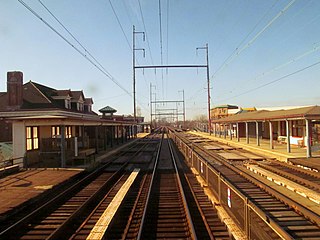
The Keystone Service is a 195 mile regional passenger train service from Amtrak between the Harrisburg Transportation Center in Harrisburg, Pennsylvania, and 30th Street Station in Philadelphia, running along the Philadelphia to Harrisburg Main Line. Most trains continue along the Northeast Corridor (NEC) to Penn Station in New York City.

MARC is a commuter rail system in the Washington–Baltimore area. MARC is administered by the Maryland Transit Administration (MTA) and operated under contract by Alstom and Amtrak on track owned by CSX Transportation (CSXT) and Amtrak. In 2023, the system had a ridership of 3,860,600, or about 12,400 per weekday as of the fourth quarter of 2023, less than pre-COVID-19 pandemic weekday ridership of 40,000.

The SEPTA Regional Rail system is a commuter rail network owned by SEPTA and serving the Philadelphia metropolitan area. The system has 13 branches and more than 150 active stations in Philadelphia, Pennsylvania, its suburbs and satellite towns and cities. It is the sixth-busiest commuter railroad in the United States, and the busiest outside of the New York, Chicago, and Boston metropolitan areas. In 2016, the Regional Rail system had an average of 132,000 daily riders and 118,800 daily riders as of 2019.

Suburban Station is an art deco office building and underground commuter rail station in Penn Center in Philadelphia. Its official SEPTA address is 16th Street and JFK Boulevard. The station is owned and operated by SEPTA and is one of the three core Center City stations on the SEPTA Regional Rail and one of the busiest stations in the Regional Rail System.

Wilmington station, also known as the Joseph R. Biden, Jr., Railroad Station, is a passenger rail station in Wilmington, Delaware. It serves nine Amtrak train routes and is part of the Northeast Corridor. It also serves SEPTA Regional Rail commuter trains on the Wilmington/Newark Line as well as DART First State local buses and Greyhound Lines intercity buses.

The Chester Transportation Center is a SEPTA bus and train station in Chester, Pennsylvania. The outside portion of the ground level serves SEPTA City Transit Division Route 37, and Suburban Transit Division Routes 109, 113, 114, 117, 118, and 119.

Trenton Transit Center is the main passenger train station in Trenton, New Jersey. It is the southernmost stop in New Jersey on the Northeast Corridor. It is the terminus for NJ Transit trains to and from New York City and SEPTA Trenton Line Regional Rail trains to and from Philadelphia, Pennsylvania, and an intermediate station for Amtrak trains traveling between the two cities along the Northeast Corridor.

The Philadelphia, Wilmington and Baltimore Railroad (PW&B) was an American railroad that operated independently from 1836 to 1881. Headquartered in Philadelphia, it was greatly enlarged in 1838 by the merger of four state-chartered railroads in three Mid-Atlantic states to create a single line between Philadelphia and Baltimore.

West Baltimore station is a commuter rail station located in the western part Baltimore, Maryland, along the Northeast Corridor. It is served by MARC Penn Line trains. The station is positioned on an elevated grade at 400 Smallwood Street near parallel West Mulberry and West Franklin Streets extending off U.S. Route 40. Three large surface lots are available for commuters. The station only has staircases from street level and two low-level side platforms next to the outer tracks and is thus not accessible to people with some mobility disabilities, but MTA Maryland plans to renovate the station with accessible platforms and entrances.

The Airport Line is a route of the SEPTA Regional Rail commuter rail system in Philadelphia, Pennsylvania, which officially runs between Philadelphia International Airport through Center City to Temple University station. In practice, however, only a few trains originate or terminate at Temple University; most are through routed with lines to the north after leaving the Center City Commuter Connection. Half of weekday trains are through routed with the Warminster Line, with the other half of weekday trains through routed with the Fox Chase Line. All weekend and holiday trains are through routed with the Warminster Line and terminate either in Warminster or Glenside.

The Wilmington/Newark Line is a route of the SEPTA Regional Rail commuter rail system in the Philadelphia area. The line serves southeastern Pennsylvania and northern Delaware, with stations in Marcus Hook, Pennsylvania, Wilmington, Delaware, and Newark, Delaware. It is the longest of the 13 SEPTA Regional Rail lines.

Malvern station is a SEPTA Regional Rail and a former Amtrak station in Malvern, Pennsylvania. Located at West King Road and North Warren Avenue, it serves most Paoli/Thorndale Line trains. Until 1998, some Keystone Service trains stopped here as well.

Prospect Park station is a station along the SEPTA Wilmington/Newark Line and Amtrak Northeast Corridor. Amtrak does not stop here; only SEPTA serves this station. The station, located at Lincoln and Maryland Avenues in Prospect Park, Pennsylvania, includes a 44-space parking lot. Like the nearby Norwood Station, Prospect Park Station is located right next to the town's library, in this case the Prospect Park Public Library. It is also located near the Borough Hall.

Newark station is a train station in Newark, Delaware, on Amtrak's Northeast Corridor, serving a limited number of Amtrak Northeast Regional trains and SEPTA's Wilmington/Newark Line regional rail trains.

The West Chester Branch is a railway line in southeastern Pennsylvania. At its fullest extent, it connected with the Philadelphia–Washington Main Line at Arsenal Junction near the University of Pennsylvania and the Philadelphia-Chicago Main Line near Frazer, Pennsylvania. It was part of the Pennsylvania Railroad (PRR) system up until the formation of Conrail in 1976. Today, SEPTA operates the Media/Wawa Line commuter service as far west as Wawa, while the West Chester Railroad heritage railway operates between West Chester station and Glen Mills.

The Penn Line is a MARC passenger rail service operating between Union Station in Washington, D.C., and Perryville, Maryland, along the far southern leg of the Northeast Corridor; most trains terminate at Baltimore's Penn Station. It is MARC's only electrified line. However, a majority of trips remain diesel powered. With trains operating at speeds of up to 125 miles per hour (201 km/h), it is the fastest commuter rail line in the United States. The service is operated by Amtrak under contract to the Maryland Transit Administration. MARC sets the schedules, owns most of the stations, and controls fares, while Amtrak owns and maintains the right-of-way, supplies employees to operate trains, and maintains the rolling stock. It is the busiest of MARC's three lines, with twice as many trains and ridership as the Brunswick and Camden lines combined.

The Pope's Creek Subdivision is a CSX Transportation railroad line in Maryland, running from Bowie to Morgantown where the Morgantown Generating Station is located and the Chalk Point Generating Station.

Perryville station is a passenger rail station on the Northeast Corridor in Perryville, Maryland. It is the northern terminus of the MARC Penn Line. The station has a single side platform serving the northern track of the four-track Northeast Corridor. The station building houses the Perryville Railroad Museum, which includes a model train layout and exhibits about the history of railroads in Perryville.

The Bowie Railroad Buildings comprise three small frame structures at the former Bowie train station, located at the junction of what is now the Northeast Corridor and the Pope's Creek Subdivision in the town center of Bowie, Maryland. The complex includes a single-story freight depot, a two-story interlocking tower, and an open passenger shed. The station was served by passenger trains from 1872 until 1989, when it was replaced by Bowie State station nearby. The buildings were restored in 1992 as the Bowie Railroad Museum and added to the National Register of Historic Places in 1998.

The Chesapeake was a daily passenger train operated by Amtrak along the Northeast Corridor between Washington, D.C., and Philadelphia, Pennsylvania, from 1978 to 1983. It was one of the few commuter trains operated by Amtrak.






















